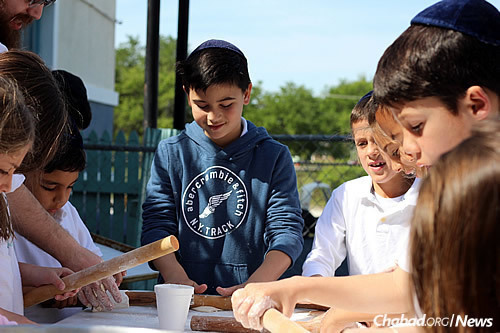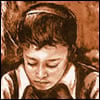Forty years ago in 1976, the Lubavitcher Rebbe—Rabbi Menachem M. Schneerson, of righteous memory—launched Mivtzah Chinuch, an ongoing global campaign to provide Jewish education to every Jewish person of every age. This is the first of a series of articles appearing throughout the school year on the worldwide network of Chabad-Lubavitch educational institutions today.
At a time when many Jewish families around the United States are struggling to give their children a Jewish education—often challenged by prohibitively high tuition costs at many Jewish day schools—one couple who arrived 30 years ago in the seaside town of Myrtle Beach, S.C., is attempting something novel this fall: providing free Jewish education for the children of virtually all local residents.
In 1986, Rabbi Doron Aizenman had completed his studies at the Lubavitch Kollel in New York after his marriage and was looking for guidance for his shlichus. He and his wife Leah, both Israelis, had every intention of returning to their home country; however, the Lubavitcher Rebbe—Rabbi Menachem M. Schneerson, of righteous memory—instructed them not to limit their options just yet.
After a short while, Aizenman heard about a beachside city in South Carolina that needed a rabbi for Passover and the High Holidays. He also learned that the locale, Myrtle Beach, was hoping to start a Jewish day school. The Rebbe gave the couple a challenging assignment: move to the small Jewish community—then mostly known as a summer destination, though full-time residents were there—and build a school.
Three years later, the Aizenmans were joined by emissaries Rabbi Yossi and Chanie Naparstek.
With the 40th-year anniversary of the Rebbe’s mitzvah campaign of Chinuch (Jewish education) approaching, the Aizenmans have ambitious plans not only to maintain students who are already attending their schools, but to attract students from new families who otherwise wouldn’t be able to afford private education.

“Simply put,” says Aizenman, “the free-tuition model is based on the old-time practice of both community and school working harder to raise the funds needed for Jewish education, relying less on individual families and more on the community as a whole.”
In addition to depending on a handful of major donors who have long been committed to Jewish education in Myrtle Beach, a task force was formed to discuss the plan and town-hall meetings were held to garner support for it. Tuition would be free for the first year to those who qualify.
In the Myrtle Beach metropolitan area, home to as many as 5,000 Jews, the goal is “100 percent participation in Jewish education,” according to Leah Aizenman, principal of Chabad Jewish Academy.
The academy teaches preschool through eighth grade. Preschool is not included as part of the free tuition program.

Two Different Tracks
Like the rest of the nation, South Carolinians have increasingly struggled with tuition, notes Leah Aizenman.
When the school was founded in 1987, there was only a kindergarten class with nine students. Each year, they added a new grade. The school drew its support from residents of the resort town, including a group of Israelis who moved there to start souvenir and T-shirt shops, such as Wings Beachwear, the clothing company started by two Israeli expats in 1977. (To this day, a large percentage of their community is comprised of Israeli transplants.)
“The owner was hiring young families with young children; he was in effect bringing them out of Israel, where they would have had everything they needed for a Jewish education,” explains Aizenman. So they decided to help fill that void.

Over the years, “the school gained a solid reputation for its educational capabilities,” she says.
For example, it received national attention in 1998 when it started the “Butterfly Project,” in which students enlisted people from around the world to create 1.5 million paper butterflies in memory of the 1.5 million children who died during the Holocaust. They then displayed the butterflies on Holocaust Memorial Day. On that day back in May this year, the Jewish community and the mayor of Myrtle Beach, among others, gathered to dedicate a new butterfly monument in memory of the children.
“It took the city by surprise; it took the world by surprise,” Rabbi Aizenman says of how the project took flight.
Nevertheless, Chabad and its school have faced challenges. Enrollment peaked in 2006 with 120 students, went to 100, and has dropped to about 70. Leah Aizenman attributes that decline in part to the local economy. “It was a typical pattern: There’s a growth spurt that stabilizes over time, so I think it’s to be expected because Myrtle Beach was so barren 30 years ago,” she explains. “There was so much opportunity for a startup, and it got saturated.”
Moreover, a growing population of Jewish retirees has formed there, drawn by the mild weather and slower pace of living.

While there are certainly families across the economic spectrum, Chabad conducted research and found that Myrtle Beach residents are less able to pay for tuition than they were at the school’s inception, according to Leah Aizenman.
Free education will be provided in two tracks: the current one, where students from preschool through eighth grade attend the Jewish academy; and a new Jewish afterschool program for elementary-school students, which they expect to start this year.
Also in the works: Chabad of Myrtle Beach began construction on a new two-story building five years ago, which will include a mikvah and a yeshivah, completing “a little bit at a time,” says Rabbi Aizenman. The shul prefers to do it this way, he adds, without borrowing money, so as not to take away from the school and the existing synagogue programs.


‘Raise the Level of Observance’
Don Habibi, a 59-year-old philosophy professor and father of six, moved to Myrtle Beach in 2004 from the port city of Wilmington, N.C., because he wanted to send his children to the day school. All of them have attended.
“I have been very impressed with their energy and devotion to strengthening Yiddishkeit and bringing Yiddishkeit to people,” he says.
Habibi feels that the school and Jewish programs in the coastal area have only been able to stay afloat because of the “tireless efforts” of Aizenman and other leaders, who Habibi says have managed to “raise the level of observance in this town.”

Take, for example, the local addition of a kosher restaurant and grocery store. Add to that visits by the Chabad emissaries to patients in hospitals, or at their homes and workplaces, engaging the entire community in Jewish life, learning, holidays and activities.
Over the years, Habibi has seen Rabbi Aizenman at places all around town and even at a lecture of his at the University of North Carolina-Wilmington, about an hour-and-a-half away.
Says Habibi: “I don’t think any one person would know all the work that they do all over the place.”
Read more articles in the series: Brooklyn Heights Jewish Academy Keeps Growing Up













Join the Discussion